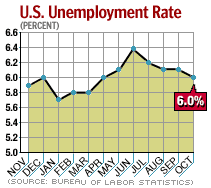NEW YORK (CNN/Money) -
Lately, economic data have been consistently surprising on the upside, so there's some talk that Friday's government report on November unemployment and payroll growth could be another blockbuster.
But there are signs that, while the report won't be a "Gigli"-like bomb by any stretch, it won't exactly be a super hit like "Finding Nemo" either.
Economists, on average, expect the Labor Department to say the unemployment rate stayed at 6 percent and that payrolls grew by 150,000 jobs in November, according to Briefing.com.

Such numbers wouldn't be bad at all. A reading of 150,000 new jobs would roughly match the average monthly growth of the labor force, keeping unemployment steady, and would make jobs growth in September to November the best three-month stretch since early 2000.
But some recent data have some Wall Streeters hoping the numbers could look a lot better than that.
The best news has come from the nation's purchasing managers. The Institute for Supply Management said this week that the employment indexes in its manufacturing and non-manufacturing surveys were both above 50 -- a level showing payrolls are growing -- for the first time since September 2000.
Since the non-manufacturing ISM survey began in 1997, in months when both employment indexes have been above 50, non-farm payrolls have grown by an average of 238,000 jobs.
Still, economists are taking the ISM numbers with a huge grain of salt, waiting for more than one month's data for confirmation that businesses are in a rush to hire the way they were during the heady bubble days a few years back.
"I wouldn't take the numbers literally, but they're clearly signaling an improvement," said UBS Warburg senior economist Jim O'Sullivan.
No skyrockets yet
UBS Warburg -- which almost perfectly predicted the number of new non-farm payroll jobs in October -- is expecting only 120,000 new jobs in November. That would be without the impact of the California grocery workers' strike, which left about 60,000 workers off payrolls in November, according to a recent Labor Department report.
| Related stories
|

|
|
|
|
Other labor market indicators are painting a picture of a job market on the mend, but not yet skyrocketing. According to the monthly survey of consumer confidence by the Conference Board, a private research firm, the percentage of consumers saying jobs are "hard to get" fell in November to the lowest level since April -- but it's still near its highest level in nearly a decade.
Some 362,000 people filed new claims for unemployment benefits in the second week of November, when the Labor Department took the surveys that will generate Friday's report.
A dip in the third week was followed by a surge in claims in the last week of November. But claims levels are still the best since February 2001, before the latest recession began.
The levels are consistent with roughly 140,000 new payroll jobs per month, according to Anthony Chan, chief economist at Banc One Investment Advisors -- a decent number, though nothing to get excited about.
"These numbers give us an indication of the trend, and the trend is still telling us we're in improvement mode, not in breakout mode, where job growth is surging," Chan said.
Still, some economists think that kind of jobs growth could come as soon as the first quarter of 2004 -- which wouldn't be a moment too soon for the unemployed people suffering through the longest "jobless recovery" since World War II.
More than 2 million people have been out of work 27 weeks or longer, the highest level in more than a decade. Non-farm payrolls are still 2.4 million jobs lighter than they were in February 2001, when the latest recession began, and nearly 800,000 jobs have been cut since November 2001, when the recession officially ended.
What's more, as the economy and labor market improve, more discouraged workers will flood back into the labor force, meaning more new jobs will need to be created every month to keep the unemployment rate from rising.
Slower-than-usual labor-force growth during the recession helped keep the unemployment rate lower than it should have been, according to Chan's research. But a recovery in labor-force growth could keep unemployment from falling much below 5.5 percent next year.
Fed still on hold
A slow return to labor-market health could allow the Federal Reserve to keep its target for its key short-term interest rate at lows not seen since the Kennedy administration.
Some influential central bank policy makers believe the labor market still has a lot of slack, meaning it will take several months of strong jobs growth before the labor force is fully utilized, putting strong upward pressure on wages and inflation.
In other words, even if Friday's payroll growth number actually does satisfy Wall Street's hope for something well north of 200,000, the Fed still won't raise interest rates when it meets to discuss policy next Tuesday.
"I doubt that, just based on Friday's number, they'll pull the trigger," said Sung Won Sohn, chief economist at Wells Fargo & Co., who this week raised his forecast for Friday's payroll number to 150,000. "They'll want to see a sustained period of inflation before they do that."
Sohn thinks central bankers instead will first drop their statement that the risk of low inflation is their "predominant" concern. Next to go would be their promise to keep rates low for a "considerable period."
But the timing of these steps will depend on the health of the labor market -- a quick return could push the Fed to move faster.

|

